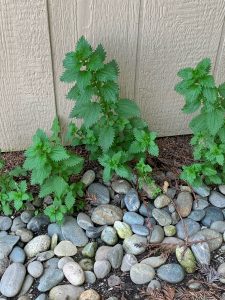Long ago when humans hunted and gathered, we knew the signs provided by Mother Nature. Squirrels and woolly caterpillars predicted that winter would be neck deep in snow or that spring was on its way. Being in harmony with woolly caterpillars could save your life.
There is still a clear picture of the timing of spring. If you lost your place on the calendar or lost your cell phone, Mother Nature provides a meteorologist view of coming weather changes. How? We can find the clear trail of spring by looking around.
In between rain showers and cold temperatures, a minute-long walk into your backyard may provide several green surprises. While many plants are sleeping, Mother Nature has assigned other plants to provide signs. Those plants have several duties; first to show us the way, second to provide nutrition at a time that little is available, and lastly to provide health benefits.
The first beacon of spring will have humans and chickens in a ring match. Chickweed, Stellaria media, loves to be in the front of the line. Cooler weather and little competition give chickweed a seat at the table. Both humans and animals have used this highly nutritious edible green. Loaded with vitamins A, D, B complex, C, calcium, phosphorus, zinc, manganese, sodium, copper, and iron, this plant make-up reads like the back of a vitamin bottle. Chickweed is the super plant during emergence from winter. The common form of chickweed is native to Europe and today is spread throughout the US. When you see chickweed, the seasons are changing.
When Gold Rush miners were looking a little scurvy, they turned to a lettuce named after them. Miner’s Lettuce, Claytonia perfoliata, is an early quick grower that’s loaded with nutrition. A good-sized salad contains one third of your daily requirement of vitamin C, 22% of vitamin A, and 10% of iron. Miner’s lettuce easily reseeds, making it easy to share the crunchy and tasty plants. This beacon of spring is now regarded as a weed; few people think of it as a gourmet salad.
An early spring, late winter plant that bites is stinging nettle, Urtica dioica. It is thought of as a weed but it is much more. The dried plant is feed for livestock. Heating or cooking the fresh leaves makes them safe to eat. Medicinal herbs and teas have been used since someone decided “if it stings; it has to be good for you” (somewhat of a mother deal). Without a pharmacy on every corner, the new growth in February was used to treat hay fever, diabetes, gout, and arthritis.
Before you grab a fork and head outside to enjoy these early risers, you must know exactly what they look like. Study attributes and widen your knowledge to keep you safe anywhere you choose to graze. Many seed catalogs have seeds if you want to plant and grow your own.
These are only a few of the early risers; Poa annua and forsythia are also good examples. Forsythia has bright yellow flowers on arching stems. Poa annua is a lime green grass that dies quickly when it gets hot. It is loved by little birds that carry the seeds everywhere.
The signs are there. Spring is coming and Mother Nature is pointing the way.
Julie Silva is a University of California Cooperative Extension Master Gardener of Tuolumne County.



